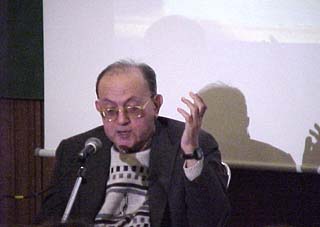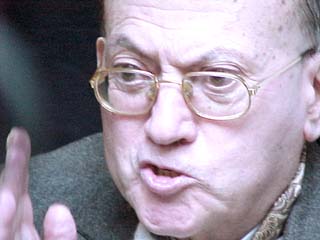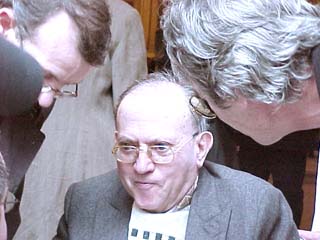
(An English translation follows the French text)

(An English translation follows the French text)
Le 21 octobre 2000 Isidore Isou participa au grand colloque annuel qui porte le titre général de "Cité de la Réussite." Cette fois les séances se déroulèrent dans les amphithéâtres de la Sorbonne, où une soixantaine de débats s'organisèrent autour du thème de l'Imagination dans tous les domaines. On vit donc la gamme des penseurs et créateurs actuels, de Elie Wiesel et Boutros Boutros-Ghali jusqu'à Sonia Rykiel, Thierry Lhermitte, Christo et Jeanne Claude.La séance d'Isidore Isou eut lieu ù l'amphithéâtre Guizot de la Sorbonne, devant une salle comble. Souffrant d'une maladie qui lui rend l'équilibre et la mobilité difficile, Isou accepta d;être présenté au moyen d'un fauteuil roulant. Avant son entrée, on projeta quelques minutes de son film qui fit scandale en 1951 au festival de Cannes - le "Traité de Bave et d'éternité." Sur l'écran on voyait un Isou jeune et séduisant qui se promenait dans le Quartier Latin, pendant que la bande sonore, suivant les principes asychroniques du cinéma lettriste "discrépant," offrait des tracts lettristes et poèmes phonétiques qui consistaient en syllabes dépourvues de sens.
Pendant une bonne demi-heure, Isou discuta de ses idées maîtresses, reconnues et appréciées par les adeptes du lettrisme qui se trouvaient dans la salle. Il parla surtout de la kladologie, la science des branches du savoir, qui permet la pensée universelle. Il parla aussi de la Créatique, son oeuvre la plus récente, destinée &agrve; assurer que le lettrisme reste ù l'avant-garde de l'avant-garde. Ensuite, il répondit aux questions de l'audience.
Mais le médicament que prenait Isou pour sa maladie avait des effets secondaires, et il ne put pas s'empêcher de baver. Puisqu'il s'agit de bave," ironisa délicatement son interlocuteur. Les réponses d'Isou devenaient progressivement difficiles ù comprendre, et ressemblaient de plus en plus aux pèoèmes phonétiques qu'on entendait au début de la séance; on finit par passer la bande sonore d'une récitation de ses poèmes, comblant sa voix vive du souvenir de ses textes.
Vers la fin de la séance, Edouard Berreur, lettriste retrouvé, prononça un texte émouvant qui résumait l'attitude générale des adeptes, disciples et admirateurs d'Isou. Il commença en évoquant son absence du mouvement et son heureux retour: Comme je t'ai connu il y a un tiers de siècle, Comme je te retrouve après un quart de siècle: Je suis heureux de t'avoir invité ici et Isou, nous te remercions profondément, et sincèrement, d'être venu Malgré tes contingences, te présenter à ce Nouveau cercle de curieux et d'amateurs du 21ième siècle.
Ensuite, Berreur a cité un commentaire de Georges Bataille publié dans la revue Critique en 1948, quand Isou avait 23 ans; il s'agissait de l'Agrégation d'un nom et d'un messie d'Isou:
"La vie du jeune Isou est celle de tout adolescent pourri de littérature (et d'innombrables connaisances), mais projeté ` travers le monde par une impudence qui bouscule - et veut bousculer:
Isou est infiniment grossier, sans moeurs et sans raison. Son récit est souvent superbe: on crierait au génie si le mot, après Isou, n'était pas superflu."L'éloge d'Isou se poursuivit et se conclut par une promesse de la part de ses fidèles de faire connaître son oeuvre:
Ce que tu considères comme ton oeuvre principale La Créatique, dissimulée depuis ton jeune age de 17 ans:
Son manuscrit est aujourd'hui pratiquement enchaîné aux enfers de la Bibliothèque Nationale. Nous t'aiderons ùà la faire connaître.
Le départ fut pénible, plein d'émotions, mais c'était aussi une sorte d'apothéose contradictoire; Isou, entouré d'admirateurs et de journalistes, fut transporté jusqu'ù l'ambulance qui l'attendait, et il quitta la cour de la Sorbonne.
Isidore Isou was the founder of Letterism over a half century ago, and he remains the intellectual and creative force uniting the movement. In a rare public appearance, he was interviewed at the Sorbonne in October, 2000, as part of a huge think tank on the imagination that included luminaries ranging from Elie Wiesel and Boutros Boutros-Ghali to Sonia Rykiel and Christo and Jeanne-Claude. The many sessions of this program of "L'imagination ù la Cité de la Réussite" were crowded into the amphitheatres of the Sorbonne, and Isidore Isou took his proper place among the people whose ideas will shape the future.
Physically restricted by a disabling illness, Isou was brought into the university halls in a wheel chair, and greeted by a full house at the Guizot amphitheatre. His presence was introduced by a showing of his infamous film, "Traitù de Bave et díeternit´," [Treatise on drool and eternity] which created a scandal at the Cannes film festival in 1951. In it a young and dashing Isou is shown walking around the Latin Quarter while his theories and phonetic poems are recited on a non synchronized sound track. The film is further degraded by marks and scratchings on the celluloid.
This provocative image of Isou fifty years ago contrasted with the mild physical presence he makes today, but in the Cité de la Rùussite symposium his mental acuity still held his audience in rapt attention as he began to elucidate and expound his ideas of "kladology," which universally links art, science, literature and society. While connoisseurs recognized the hypotheses which Isou introduced to predict some of the major changes in society and economy during the decades of the I960s, 70s and 80s, the audience strained to follow the rapid succession of ideas coming from Isou still today.
Indeed, the Letterist master conceded that his medication contributed to progressively uncontrolled drooling, an ironic reminder of the title of his early film, and eventually his words became impossible to comprehend, sounding more like one of the phonetic poems with which he had challenged intelligibility in language. Someone put on a recording of one of those old sound poems, and its chanting covered Isouís voice.
The moment of public debate and presentation passed into a surge of support for the expansive thinker whose means of oral expression had been stolen from him by cruel fate. At the conclusion of the session, Letterist Edouard Berreur pronounced a text which captured the emotions and sentiments of the devoted audience, citing a 1948 critique by Georges Bataille who said, "His discourse is often superb: one might call him a genius except that after Isou the word seems superfluous." Berreur went on to recall Isou's extreme efforts and to hope for the future propagation of his latest writing, La Créatique, a work on continuous creativity, which he hopes will assure his role in being at the avant-garde of the avant-garde.
In an emotional departure, Isou was transported back to an awaiting ambulance, and he proceeded with a patient smile through the crowd of well-wishers, journalists and old faithful Letterists, then left the courtyard of the Sorbonne.
- Recounted by David Seaman In the photos we have, beginning at the top of the page, Isou in the Guizot Amphitheatre of the Sorbonne; then, continuing at the botom of the page, Isou CU inside; Isou outside in the courtyard crowded by well-wishers; Isou being interviewed by a journalist, with Edouard Berreur on the left, Roland Sabatier on the right.


Return to Isidore Isou Home Page Return to Lettriste Pages Main Index.
Return to Kaldron | Light and Dust
This is a cooperative publication of
Kaldron On-Line and
Light and Dust Anthology of Poetry